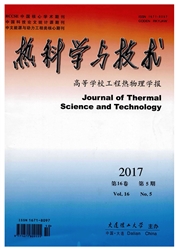

 中文摘要:
中文摘要:
To improve energy conversion efficiency, optimization of the working fluids in organic Rankine cycles(ORCs) was explored in the range of low-temperature heat sources. The concept of unit-heat-exchange-area(UHEA) net power, embodying the cost/performance ratio of an ORC system, was proposed as a new indicator to judge the suitability of ORC working fluids on a given condition. The heat exchange area was computed by an improved evaporator model without fixing the minimum temperature difference between working fluid and hot fluid, and the flow pattern transition during heat exchange was also taken into account. The maximum UHEA net powers obtained show that dry organic fluids are more suitable for ORCs than wet organic fluids to recover low-temperature heat. The organic fluid 1-butene is recommended if the inlet temperature of hot fluid is 353.15-363.15 K or443.15-453.15 K, heptane is more suitable at 373.15-423.15 K, and R245 ca is a good option at 483.15-503.15 K.
 英文摘要:
英文摘要:
To improve energy conversion efficiency, optimization of the working fluids in organic Rankine cycles(ORCs) was explored in the range of low-temperature heat sources. The concept of unit-heat-exchange-area(UHEA) net power, embodying the cost/performance ratio of an ORC system, was proposed as a new indicator to judge the suitability of ORC working fluids on a given condition. The heat exchange area was computed by an improved evaporator model without fixing the minimum temperature difference between working fluid and hot fluid, and the flow pattern transition during heat exchange was also taken into account. The maximum UHEA net powers obtained show that dry organic fluids are more suitable for ORCs than wet organic fluids to recover low-temperature heat. The organic fluid 1-butene is recommended if the inlet temperature of hot fluid is 353.15-363.15 K or443.15-453.15 K, heptane is more suitable at 373.15-423.15 K, and R245 ca is a good option at 483.15-503.15 K.
 同期刊论文项目
同期刊论文项目
 同项目期刊论文
同项目期刊论文
 An Assessment of the Effects of Micron-Particle Aggregation on the Performance of Zinc-Silica Compos
An Assessment of the Effects of Micron-Particle Aggregation on the Performance of Zinc-Silica Compos Multiple-response optimization for melting process of aluminum melting furnace based on response sur
Multiple-response optimization for melting process of aluminum melting furnace based on response sur Prediction model of flow boiling heat transfer for R407C inside horizontal smooth tubes based on RBF
Prediction model of flow boiling heat transfer for R407C inside horizontal smooth tubes based on RBF 期刊信息
期刊信息
